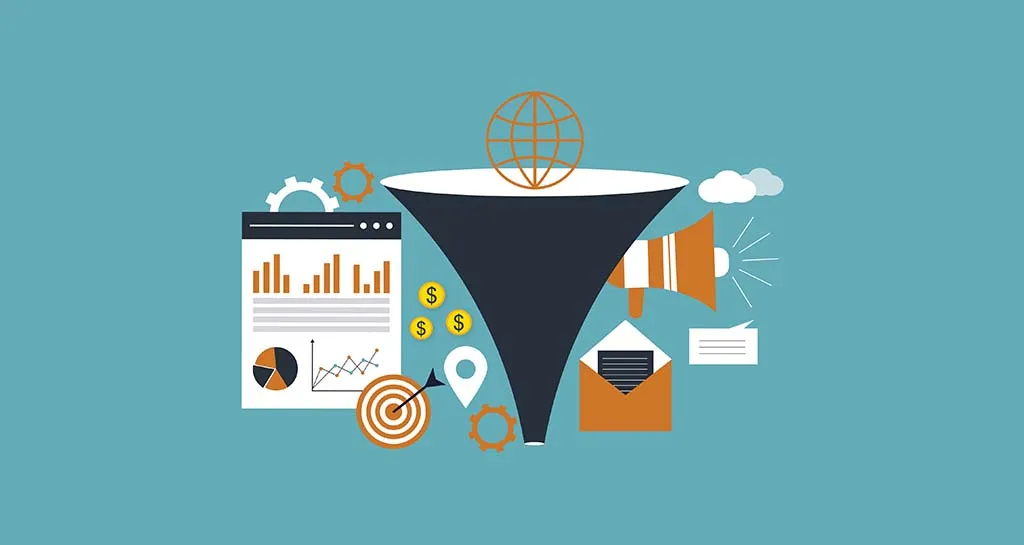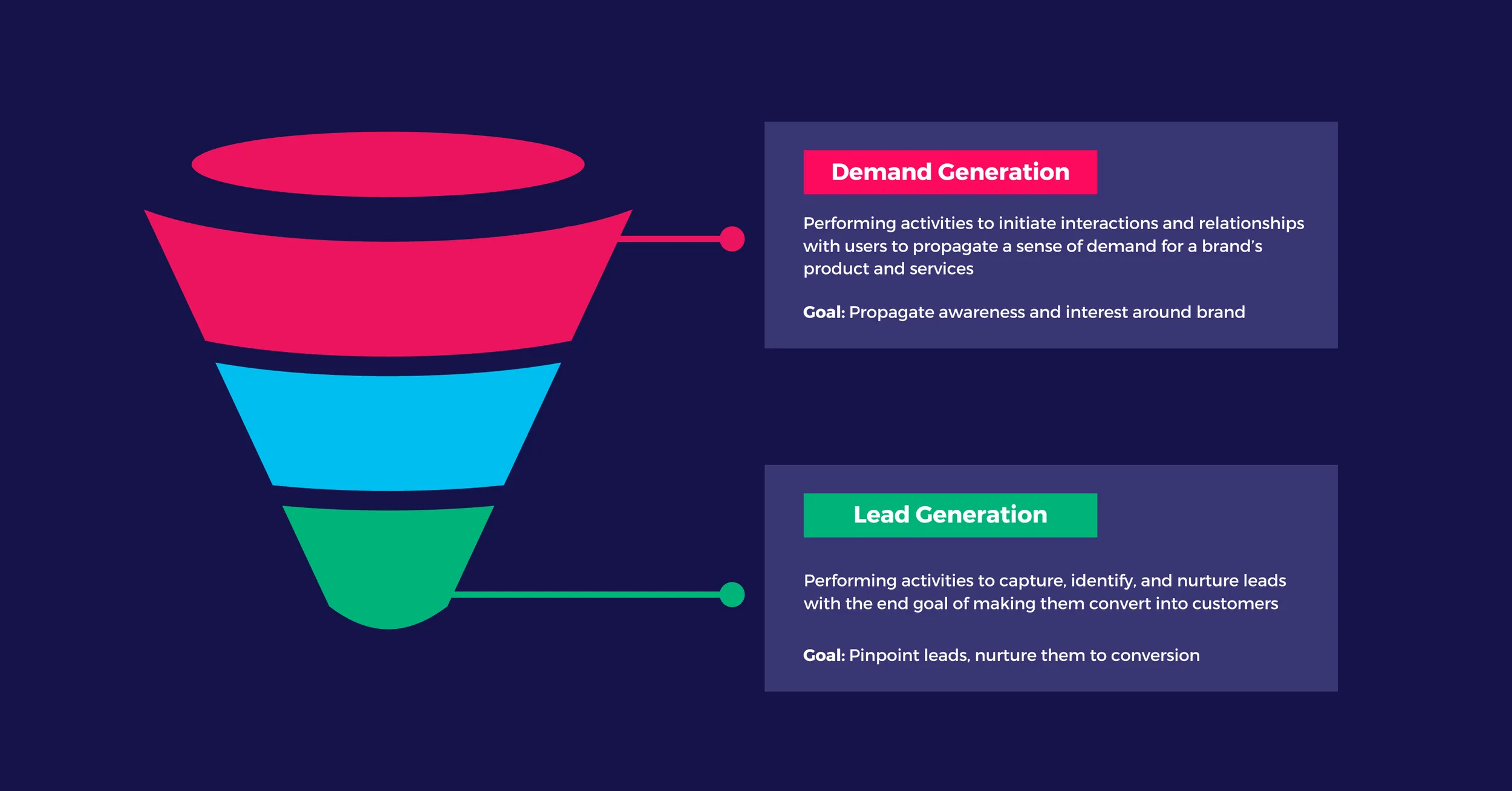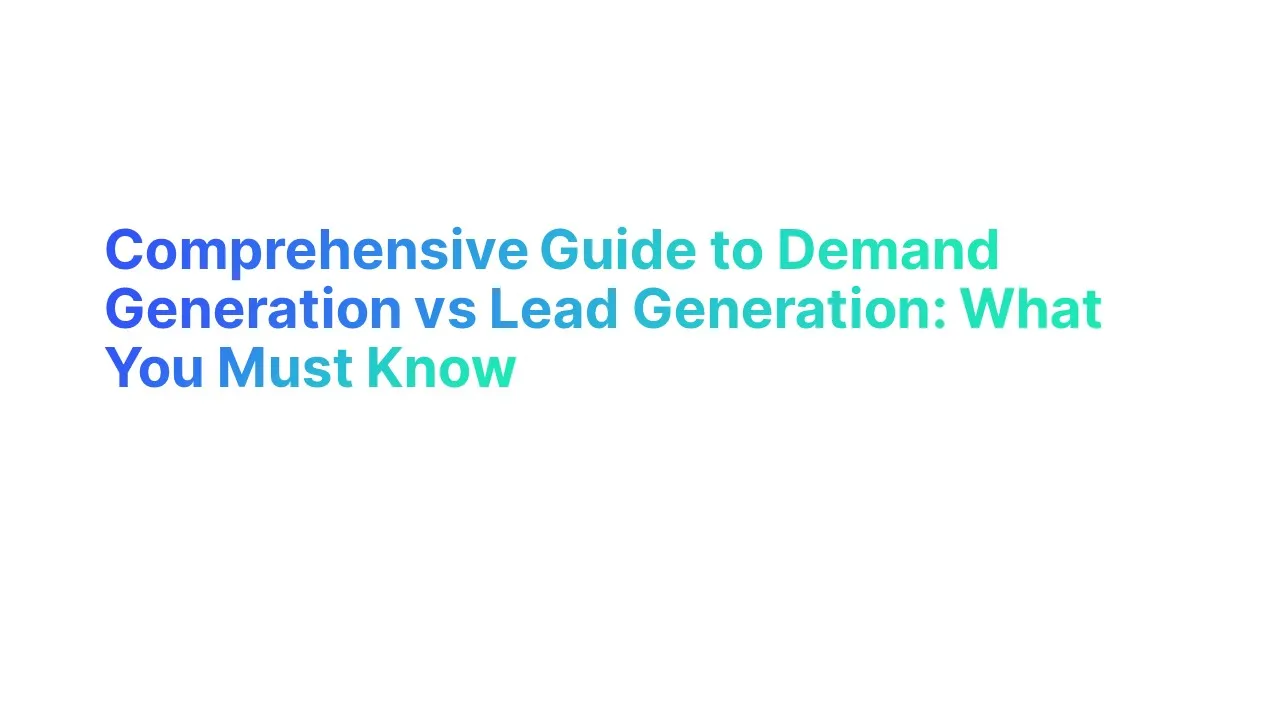What is Demand Generation?

Demand generation is a comprehensive marketing approach designed to generate interest in a company's products or services. This strategy involves a series of marketing efforts aimed at creating demand for a product or service, rather than merely capturing existing demand.
Key activities in demand generation include:
Demand Generation Campaigns: These are targeted initiatives designed to raise awareness and stimulate interest among potential customers. Campaigns often leverage multiple channels such as social media, email, and content marketing.
Creating Demand: By identifying and tapping into the needs and interests of a target audience, companies can actively create a need for their products or services. This involves educating potential customers about problems they may be facing and presenting the company’s offerings as solutions.
Demand Generation Content: The use of strategic content plays a crucial role. This includes thought leadership articles, informative blogs, and educational webinars that help build authority and trust in the market.
Demand Generation Tactics: Techniques such as search engine marketing, influencer marketing, and free resources like eBooks or white papers are used to attract and engage prospective customers.
What is Lead Generation?

Lead generation is the targeted marketing process aimed at attracting and converting prospects into individuals who have shown interest in a company's products or services.
Unlike demand generation, which focuses on building long-term demand, lead generation is immediate and transactional, directly feeding leads into the sales pipeline for pursuit by sales teams.
Key activities involved in lead generation:
Lead Generation Strategies: These are deliberate plans designed to capture the interest of potential customers. Strategies often include targeted promotions and specially crafted content to engage specific market segments.
Lead Generation Campaigns: These are specific initiatives aimed at gathering the contact details of potential customers. Typical campaigns might utilize sign-up forms on websites, landing pages specifically designed to capture leads, and calls to action that prompt user engagement.
Lead Generation Techniques: Effective techniques in lead generation include the optimization of landing pages to increase conversion rates, the use of lead magnets such as free trials or product demos to entice users, and robust email marketing campaigns that nurture leads through the sales funnel.
Qualified Leads: A crucial component of lead generation is the focus on not just any leads, but qualified leads. These leads are evaluated for their potential to purchase, categorized as either marketing qualified leads (MQLs) or sales qualified leads (SQLs), which indicates their readiness to be approached by sales teams.
Difference Between Lead Generation and Demand Generation

3 Considerations When Prioritizing Between Lead Gen and Demand Gen

In marketing, understanding whether to focus on lead generation tactics (lead gen) or demand generation tactics (demand gen) can significantly influence the effectiveness of your campaigns.
Each strategy serves distinct purposes and is driven by different activities and metrics. Here are three critical considerations to help determine the priority between lead gen and demand gen for your business.
1. Goals and timing
Goals:
Lead Generation: This strategy is about immediate results. The main goal is to generate leads that can quickly be turned over to the sales team. Lead gen is particularly effective in scenarios where the aim is to drive rapid sales growth, such as in response to market opportunities or competitive pressures.
Demand Generation: In contrast, demand gen is about creating a sustainable interest in your products or services over time. It focuses on educating the market and building brand awareness, which are essential for long-term business growth and for entering new markets.
Timing:
Lead Generation: Lead gen campaigns are often short-lived, with a clear start and end date, and are focused on achieving quick wins that impact sales directly and immediately.
Demand Generation: This approach requires patience and persistence, as it involves longer-term campaigns that aim to gradually build up a solid base of interested prospects. Demand gen often sees results over months or years rather than days or weeks.
2. Content focus and channels
Content Focus:
Lead Generation: Content under this strategy is typically direct and highly targeted, aiming to convert prospects into leads as efficiently as possible. Common forms include promotional emails, targeted ads, and conversion-optimized landing pages.
Demand Generation: Content for demand gen is designed to engage and educate potential customers, establish thought leadership, and nurture relationships over time. It often includes blogs, white papers, infographics, and video content that provide value to the audience without overt selling.
Channels:
Lead Generation: Effective channels are those that support direct response tactics, such as pay-per-click (PPC) advertising, social media ads, and direct email marketing.
Demand Generation: Channels for demand gen are broader and more varied, often focusing on content distribution and engagement. These include SEO, social media platforms, content syndication, and public speaking at industry events.
3. Metrics and measurement
Metrics:
Lead Generation: Key metrics include lead quantity, lead quality, conversion rates, cost per lead, and overall ROI. These metrics are critical for assessing the immediate impact of lead generation activities on the company's bottom line.
Demand Generation: Focuses on longer-term metrics such as brand awareness, engagement rates, customer loyalty, and market influence. These are less about immediate sales conversions and more about the overall health and perception of the brand in the marketplace.
Measurement:
Lead Generation: Emphasizes tracking and optimizing the sales funnel and performance of each campaign to maximize conversions. Tools like CRM systems and analytics platforms are often used to measure success.
Demand Generation: Involves continuous analysis of market trends and brand positioning. The effectiveness is often measured through audience growth, content engagement, and incremental improvements in brand recognition and customer relationships.
Deciding whether to prioritize lead gen or demand gen should be based on the company’s strategic goals, available resources, and market positioning.
Each has its strengths and suits different stages of business growth and market conditions, thus a balanced approach often proves most effective in achieving comprehensive marketing objectives
Demand Generation Techniques
Content Marketing:
- Blogs: Regularly publishing high-quality, informative blog posts on topics relevant to your industry to attract and engage readers.
- eBooks and Whitepapers: Creating in-depth resources that provide value and position your brand as an industry leader.
- Videos: Producing educational or entertaining videos that highlight industry insights, product uses, or customer stories.
Social Media Marketing:
- Brand Awareness Campaigns: Running campaigns on platforms like LinkedIn, Twitter, and Instagram to increase brand visibility and engagement.
- Influencer Partnerships: Collaborating with influencers to reach a broader audience and build credibility.
Webinars and Live Events:
- Educational Webinars: Hosting webinars on industry trends, best practices, or product-related topics to attract and engage a target audience.
- Industry Conferences: Participating in or sponsoring conferences and trade shows to network and create awareness about your brand.
SEO and Organic Search:
- Optimizing Content: Ensuring your website and content are optimized for search engines to attract organic traffic.
- Building Backlinks: Creating high-quality backlinks to improve search engine rankings and increase visibility.
PR and Media Outreach:
- Press Releases: Distributing press releases to announce new products, company milestones, or industry insights.
- Media Coverage: Securing coverage in industry publications or news outlets to build credibility and reach a wider audience.
Demand Generation Examples
Educational Webinars:
- Example: Hosting a webinar titled "The Future of AI in Marketing" featuring industry experts.
- Purpose: To educate the audience about the potential of AI in marketing, sparking interest and awareness about AI solutions.
- Outcome: Builds brand authority and broad interest without immediate expectation of sales.
Content Marketing:
- Example: Publishing a comprehensive eBook on "Effective Content Strategies for Startups" and promoting it widely.
- Purpose: To provide valuable information and position the brand as a thought leader in content strategy.
- Outcome: Increases brand visibility and engages potential customers at the top of the funnel.
Social Media Campaigns:
- Example: Running an Instagram campaign showcasing customer success stories and innovative product uses.
- Purpose: To generate interest and excitement around the brand and its offerings.
- Outcome: Creates brand awareness and fosters a community of engaged followers.
Lead Generation Techniques
Landing Pages with Lead Capture Forms:
- Optimized Landing Pages: Creating dedicated landing pages for specific offers, such as free trials, demos, or consultations, with forms to capture lead information.
- A/B Testing: Testing different landing page elements to maximize conversion rates.
Email Marketing:
- Targeted Campaigns: Sending personalized email campaigns to nurture prospects and convert them into leads.
- Lead Magnets: Offering valuable content (e.g., eBooks, case studies) in exchange for contact information.
Paid Advertising:
- PPC Campaigns: Running pay-per-click (PPC) campaigns on Google Ads or Bing Ads to capture leads searching for relevant keywords.
- Social Media Ads: Utilizing Facebook, LinkedIn, and Instagram ads to target specific audiences and drive them to lead capture pages.
Referral Programs:
- Incentivizing Referrals: Creating programs that reward current customers for referring new leads.
- Partner Networks: Collaborating with complementary businesses to generate leads through shared audiences.
Chatbots and Live Chat:
- Website Chatbots: Implementing chatbots on your website to engage visitors and capture lead information in real time.
- Live Chat Support: Offering live chat support to answer questions and capture leads from interested visitors.
Content Upgrades:
- Gated Content: Offering premium content, such as advanced guides or templates, that require users to submit their contact information to access.
- Interactive Content: Using quizzes, assessments, or calculators that provide value and capture leads based on user input.
Lead Generation Examples:
Landing Pages with Forms:
- Example: Creating a landing page offering a free trial of your software with a form to capture contact information.
- Purpose: To collect information from potential customers who are interested in trying out the product.
- Outcome: Generates leads that can be nurtured through the sales funnel.
Email Marketing Campaigns:
- Example: Sending targeted emails offering a free consultation or demo in exchange for filling out a contact form.
- Purpose: To directly capture information from potential customers interested in learning more about the product.
- Outcome: Converts interested individuals into leads for follow-up by the sales team.
Paid Advertising with Lead Magnets:
- Example: Running a LinkedIn ad campaign offering a free whitepaper download in exchange for email addresses.
- Purpose: To attract specific prospects and capture their contact details for further engagement.
- Outcome: Directly collects leads who have shown interest in the topic by downloading the whitepaper.
How Do Demand Gen and Lead Gen Come Together?

In a comprehensive marketing strategy, demand generation and lead generation are not mutually exclusive but rather interconnected components that work synergistically to maximize overall effectiveness.
Understanding how to integrate these two approaches can lead to more successful marketing outcomes, from increased brand awareness to higher conversion rates. Here’s how demand gen and lead gen come together in a cohesive marketing strategy:
Foundation of Demand Generation
Demand Generation is the broader scope of marketing efforts aimed at creating long-term demand for a product or service. This strategy is focused on generating awareness and establishing a brand presence within the target market. Key aspects include:
- Educational Content: Producing high-quality, informative content that addresses the pain points and needs of the target audience.
- Brand Awareness Campaigns: Utilizing various channels to increase visibility and credibility, such as SEO, social media, public relations, and content marketing.
- Engagement Initiatives: Engaging with the audience through webinars, workshops, and community involvement to build trust and authority.
These efforts ensure that the market is not only aware of the brand but also trusts and sees value in its offerings.
Transition to Lead Generation
Lead Generation takes the interest and awareness built by demand generation activities and converts it into actionable leads. It is more direct and immediate in its approach to capturing the interest of potential customers who have been nurtured through demand gen strategies. Key tactics include:
- Targeted Campaigns: Implementing specific campaigns aimed at segments of the audience that have shown interest or interacted with demand generation content.
- Conversion-focused Content: Using more direct calls-to-action within content, such as gated eBooks, free trials, and demos that require users to submit contact information.
- Personalized Follow-ups: Employing email marketing or retargeting ads that remind potential leads of the solutions offered, tailored to their interactions with previous content.
Integration Points
Content Strategy:
- Lead Gen Focus: Content specifically designed for conversion, such as case studies or product demos, can be promoted to audiences who have engaged with broader demand gen content.
- Demand Gen Foundation: Educational and thought leadership content serves as a precursor, setting the stage for more direct lead gen tactics by building knowledge and trust.
Marketing Automation:
- Automated workflows can be used to segment audiences based on their engagement levels and deliver personalized content that moves them from general awareness (demand gen) to specific interest (lead gen).
Analytics and Feedback:
- Data gathered from both demand gen and lead gen efforts can inform each other. Insights into which types of content drive the most engagement can shape future content creation, while conversion data helps refine targeting and personalization strategies.
Cross-Channel Coordination:
- Coordinating messaging across channels ensures a seamless transition for the buyer from learning about a problem and potential solutions (demand gen) to choosing a specific product or service (lead gen).
By aligning demand generation and lead generation strategies, marketers can ensure that each stage of the buyer’s journey is addressed effectively, from initial awareness and education to decision-making and purchase.
This cohesive approach not only improves the efficiency of marketing efforts but also enhances the overall customer experience, leading to better conversion rates and customer loyalty.
Key Components of a Demand Generation Strategy

A successful demand generation strategy is designed to cultivate long-term interest and engagement, leading to a steady flow of qualified leads. Here’s a detailed look at the essential components:
1. Employ Tools Focused on Amplification and Analysis
Amplification and Analysis Tools are crucial for scaling demand generation efforts and measuring their effectiveness. This involves:
- Marketing Automation Platforms: These tools help automate repetitive tasks, manage email campaigns, and segment the audience based on their behavior and engagement.
- Analytics and Data Management: Tools like Google Analytics, CRM systems, and advanced data analytics platforms provide insights into how potential buyers interact with your content and where they drop off in the sales funnel.
- Social Media Management Software: Platforms like Hootsuite or Buffer aid in scheduling posts, analyzing social media traffic, and engaging with users to amplify reach and impact.
2. Set Focused Goals
Clear, focused goals are vital to direct and measure the success of demand generation campaigns. These should be:
- Specific and Measurable: Goals should be quantifiable (e.g., increase web traffic by 20% within six months).
- Aligned with Business Objectives: Ensure that the goals contribute directly to broader business outcomes, such as revenue targets and market expansion plans.
- Based on Buyer Journey Insights: Tailor goals to address specific stages of the buyer's journey, from awareness through consideration to decision.
3. Build Awareness
Raising awareness is about making potential buyers aware of their challenges and your solutions. Effective tactics include:
- Content Marketing: Leveraging blogs, articles, white papers, and videos that address common industry challenges or pain points.
- SEO and SEM: Optimizing content for search engines to ensure it reaches the target audience looking for related information.
- Public Relations and Media Outreach: Engaging with media and industry influencers to get your brand mentioned in news articles, interviews, and podcasts.
4. Explore Brand-Appropriate Alternative Marketing Strategies
To stand out in a crowded market, consider alternative marketing strategies that resonate with your brand identity and appeal to your target audience:
- Influencer Marketing: Partnering with industry leaders or influencers who can authentically endorse your products.
- Event Marketing: Hosting or participating in webinars, workshops, or conferences that provide value to attendees while showcasing your expertise.
- Community Building: Creating or sponsoring online forums or groups where potential customers can discuss industry issues, positioning your brand as a helpful resource.
5. Create Informative and Useful Free Content
Free content not only attracts interest but can also be a critical tool in nurturing leads:
- Ebooks and Guides: Provide comprehensive insights into industry topics or solutions, helping prospects understand their needs better and how they can be met.
- Webinars and Tutorials: Offer practical, step-by-step guidance or thought leadership on relevant subjects that help prospects engage with your brand on a deeper level.
- Templates and Tools: Supply your audience with free templates or tools that can assist them in their day-to-day tasks, subtly embedding your brand into their workflow.
Employing these components in your demand generation strategy helps not only in generating demand but also in nurturing prospects through a well-thought-out sales funnel. This holistic approach ensures that marketing efforts translate into sales-qualified leads, ultimately contributing to the company's revenue and growth.
Key Components of a Lead Generation Strategy

A robust lead generation strategy is essential for attracting potential customers and converting them into leads that your sales team can pursue.
By effectively implementing these components, businesses can enhance their marketing efforts, improve conversion rates, and ultimately drive revenue. Here’s a detailed look at the essential components:
1. Establish a Lead Capture Model
The foundation of any lead generation strategy is a solid lead capture model, which outlines how leads will be collected and managed. Key aspects include:
- Data Capture Forms: Design forms that are easy to fill out and placed strategically across your website, especially on high-traffic pages.
- Customer Relationship Management (CRM) Integration: Ensure all lead data is automatically fed into your CRM system for effective tracking and management.
- Lead Segmentation: Categorize leads based on their actions, demographics, or engagement levels to tailor follow-up communications effectively.
2. Develop Your Lead Magnets
Lead magnets are incentives offered to potential leads in exchange for their contact information. They should provide significant value to your target audience to encourage sign-ups. Examples include:
- Ebooks and Whitepapers: Provide detailed insights into industry trends or solutions to common problems.
- Free Trials or Demos: Offer a hands-on experience of your product or service.
- Webinars and Workshops: Host live sessions that address key topics of interest to your target market.
Creating compelling lead magnets is critical as they are the initial touchpoint in capturing interested prospects and converting them into leads.
3. Optimize Landing Pages
Landing pages are critical in converting visitors into leads by focusing them on a single action. Optimization strategies include:
- Clear and Concise Messaging: Ensure the value proposition is straightforward and compelling.
- Strong Call-to-Action (CTA): Use visually distinct, action-oriented CTAs that tell visitors exactly what to do.
- A/B Testing: Regularly test different elements of your landing pages (like headlines, images, and CTAs) to determine which versions perform the best.
Optimized landing pages reduce friction in the lead conversion process, making it easier for visitors to make the decision to engage with your content and enter your sales funnel.
4. Leverage Social Media
Social media platforms can be powerful tools for generating leads by engaging directly with potential customers. Strategies include:
- Targeted Ads: Use the sophisticated targeting options available on platforms like Facebook and LinkedIn to reach specific demographics or interest groups.
- Engaging Content: Regularly post content that resonates with your audience, encourages interaction, and drives traffic to your lead capture pages.
- Community Building: Create and nurture online communities to keep your brand top-of-mind and foster trust, which can lead to more leads over time.
5. Use Marketing Automation Workflows
Marketing automation is key to scaling your lead generation efforts. It allows for the automatic handling of tasks that would otherwise require manual effort, such as:
- Email Drip Campaigns: Automatically send a series of emails based on specific triggers or lead behaviors that nurture leads through the sales funnel.
- Lead Scoring: Use automated systems to score leads based on their engagement, helping prioritize follow-up by the sales team.
- Lead Nurturing: Deliver targeted content and offers to leads based on their previous interactions and stage in the buying cycle.
Implementing these key components effectively can drastically improve the efficiency and success of your lead generation strategy. By focusing on these areas, you can generate higher quality leads, enhance your marketing qualified lead (MQL) pool, and ultimately provide your sales team with better prospects that have a higher likelihood of converting into paying customers.
Demand Generation vs Lead Generation Conclusion
While demand generation and lead generation might seem like distinct practices, their integration is essential for any business aiming to thrive in today’s competitive market. A balanced approach, where both strategies inform and enhance each other, will not only generate leads but also build the kind of demand that sustains a business long-term. The successful marketer will navigate these strategies not as isolated tactics but as complementary forces that drive the company's growth and brand value forward.





.webp)


